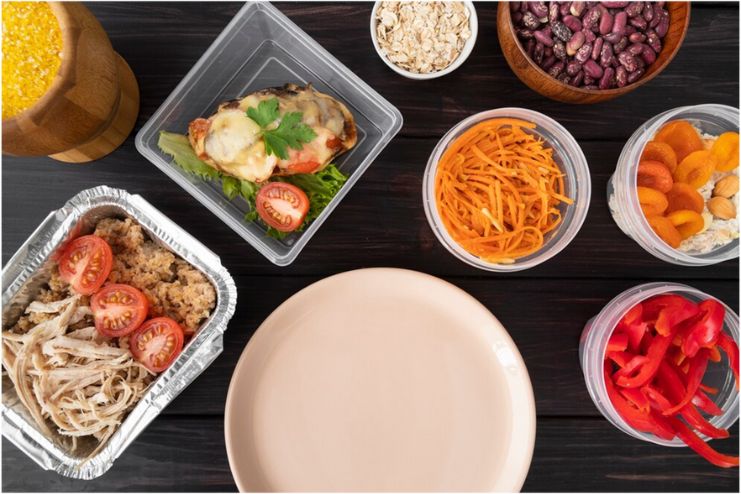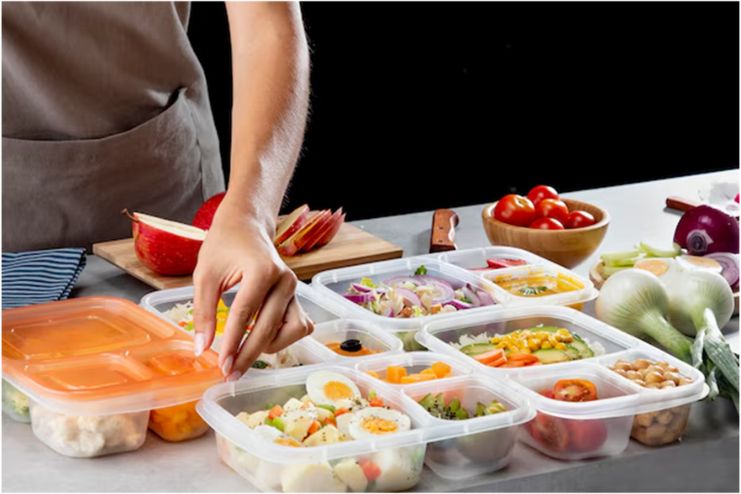Affiliate Disclaimer
Some links in this article are affiliate links. We may earn a small commission if you make a purchase through these links, at no extra cost to you. We only recommend products we find useful to our readersOur busy schedules are packed with tasks to attend, and meal preparation is one of those. Dining out is not always possible; home-cooked meals are better in many ways. However, planning and preparing meals every day can be tiring at times. Even if you love to cook, planning, arranging ingredients, chopping vegetables, and cleaning all that mess afterward can be daunting. This is when you can rely on meal delivery kits. Their popularity has soared in recent years, as it is a quick way to get ready-to-cook meals delivered to your doorstep. This article will help us understand what meal kits are, their pros and cons in general, and how to manage weight.
What Are Meal Kits?

Meal kits are a subscription-based service. These meals have pre-portioned ingredients and detailed recipes delivered directly to customers’ doorsteps. The bonus here is that you can cook these at home without additional meal preparation or grocery shopping. This convenience has made them a favorite choice in the U.S. You get healthy home-cooked meals with zero meal prep hassles.
Key Points About Meal Kits:
How they work:
- The customers select a meal plan according to their dietary preferences and desired servings.
- Each meal kit contains pre-measured ingredients that suit the recipe and easy instructions.
- The delivery is scheduled to make it more structured.
Meal delivery kits are a go-to option for many working professionals, busy parents, or even the elderly. However, their popularity comes with a few doubts. People often question their nutrition, hygiene, and other aspects.
Meal delivery kits are quite popular in the U.S. They were valued at an astounding USD 20.54 billion as of 2022. The market size of meal kits is expected to grow at a compound annual growth rate (CAGR) of 15.3% from 2023 to 2030.
Reasons For Popularity:
- Convenience: Meal kits have become popular in the USA. They help people by eliminating the need to plan meals and shop for groceries, which is convenient and comforting.
- Variety: If you opt for a meal kit, you can try various cuisines and flavors.Healthy eating: Most meal kits are designed to provide balanced nutrition and portion control, making them a go-to option for fitness enthusiasts.
- Cooking: People learn to cook new recipes with new techniques and develop their cooking skills. They find the recipes easy to follow and love to cook from a meal kit.
Market Trends In U.S:
- Significant Growth: Meal kit subscriptions have grown significantly in recent years. HelloFresh, Blue Apron, and Green Chef hold a large market share.
- Target Demographic: Due to their busy lifestyles, millennials and Gen Z are the primary consumers of meal kits.
Benefits Of Meal Kits For Weight Management:

- Portion Control: Balancing health, managing time, and saving efforts to cook, all of these are possible with meal kits. You take the guesswork out of serving sizes and prevent overeating. This way, you don’t just eat balanced meals but also portion-controlled meals. The pre-measured ingredients ensure you stick to the proper portions and do not over-consume calories.
- Convenience: Meal kits save time and effort. All you have to do is use the ingredients given and follow the recipe step-by-step. This averts your temptation to eat something unhealthy.
- Nutritional Balance: You do not have to worry about nutrition if you opt for meal kits. Often, meal delivery kit services are designed by a dietician, making them balanced meals of proteins, carbs, and fats. A few meal kits also provide relevant information about nutrition and help you stay on track.
Many people still find meal kits to be less lucrative. There are a few differences in how people perceive meal kits and their benefits.
Key Drawbacks Of Meal Kits:
Meal kits can be expensive sometimes. They often rely on pre-portioned ingredients and offer a limited scope of customization. Excessive packaging is another disadvantage, which can discourage some people from trying the meal kit option.
Here are a few cons of meal kits regarding nutrition:
- Nutrition: The meal kits might lack the required nutrition, making it a significant disadvantage. These may be high in saturated fats or sodium, making them a less preferred way to stay healthy.
- Portion sizes: Health-wise, meal kits might have imbalanced portion sizes, and if we are not careful, we may gain weight.
- Preparation: Few meals require extra ingredients, which may not be the best option nutrition-wise. Hence, meal kits might make you use more than the required spices, leading to gut issues.
- Dietary restrictions: If you have dietary restrictions, like dairy or gluten, meal kits might sometimes not offer a tasty meal that caters to your needs. Also,meal kits may have a few ingredients that do not suit some people who are allergic.
Other drawbacks include:
- High cost per serving: Sometimes, meal kits cost more per meal, that is per serving, than buying separate ingredients from the grocery store. The delivery fees also add to the expense, making it costlier.
- Limited flexibility: Meal kits have pre-measured ingredients and instructions to cook, making them a restricted choice. People cannot experiment with tastes, flavors, or ingredients and have less freedom to adjust portions taste-wise.
- Excessive packaging waste: Plastic packaging is used to retain the freshness of food in meal kits. Moreover, individual ingredients are packed in plastic, which creates a lot of waste afterward. This adds to environmental waste, as plastic is harmful if not recycled well.
When we discuss meal kits in the U.S., the two most popular companies come into the picture. These are the meal kit services by Blue Apron and HelloFresh that cater to various meal needs and provide convenience to busy households.
Both companies are favored across the country regarding calorie-conscious options, dietary plans, customizations, and weight management needs. Here’s a comprehensive comparison to understand which one better suits weight management needs.
HelloFresh vs. Blue Apron

Blue Apron:
It designs healthy meals that are “WW approved.” The company also offers “Wellness” meals, a healthier choice. The only drawback is its limited menu, which doesn’t help people with specific dietary needs.
The recipes on Blue Apron are complex yet sophisticated. The dishes are globally famous, making people expand their cooking skills. Consider this if you prefer to spend time on cooking.
HelloFresh:
HelloFresh has a broader menu that includes various diet-specific options. The menu caters to vegetarians, pescatarians, and people on a diet. This is the best option for people looking to manage weight, as it has a ‘Calorie smart’ plan.
HelloFresh offers simpler, straightforward recipes. These recipes aim to save time and help you manage weight. With simple meal preparation, people striving for quick meals can opt for HelloFresh.
Both HelloFresh and Blue Apron are prominent meal kit services in the U.S.; However, one must consider one’s time, schedule, dietary needs, and interests while picking the right one. If you are confused, here are some tips for choosing the right meal kit.
Tips to Choose the Right Meal Plan:
- Check for Low-calorie Menus:
You must search for and opt for meal kits with a calorie-smart feature. This feature supports weight management and controls portion size. Understand the calories per serving and select the best option that aligns with your fitness goals. - Focus on Nutrient-Dense Meals:
Depending upon meal kits does not necessarily mean you eat unhealthy food. Focus on balanced meals with lean proteins, whole grains, and lots of vegetables. These meal kits not only fill your stomach but also fuel your energy. - Customize:
Opt for meal kits with a customization option. Many meal kits are keto-friendly, offer vegan options, and align with your specific dietary needs. - Match Prep Time to Your Schedule:
You must not just check the nutritional value but also see and compare the preparation time. Choose a service that fits your schedule and aligns with your cooking skill level.
Conclusion:
Meal delivery kits have become a norm for people who wish to save time yet have hygienic home-cooked meals. These kits help save time, provide balanced nutrition, and offer variety. Their convenience and structured plan help busy individuals manage their schedules and diets at a time. The meal kits help in portion control without sacrificing quality or taste.
To opt for a meal kit service, you must weigh the pros and the cons. It depends on your choice to select among prominent services such as Blue Apron or HelloFresh, depending on your personal goals and needs.
Explore options, understand your needs and goals, and select the best meal kit. Save preparation time and effort and include meal kits in your journey towards healthier and cleaner eating.
References
- https://www.grandviewresearch.com/industry-analysis/meal-kit-delivery-services-market
- https://www.researchandmarkets.com/reports/5318374/meal-kit-delivery-services-market-size-share-and?srsltid=AfmBOopNi8wZMu4yU-QxbGxmWSASHgHoTvqyplTZ4SxhrOF1eJBbaAe0
- https://www.healthline.com/nutrition/healthy-meal-delivery
- https://nutritionsource.hsph.harvard.edu/healthy-eating-plate/
In this Article

















